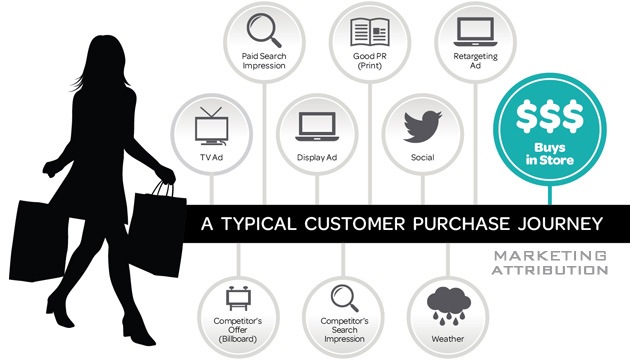
BEC高级文章阅读精选:四不成功实施营销归因法(利用营销归因法增加投资回报率操作指南)
导读:营销归因法是指应用统计方法为购物路径上的每一个接触点分配一个权重值,然后通过这个值归纳分析在不同营销接触点促进销售额的相对强度的新型行销方法。使用营销归因法能够帮助营销人员了解消费者在什么时间、以及通过何种渠道爆光在我们的营销网络覆盖面的。
以下文章选自Marketing Pros,本文结合近年来的市场营销环境,为营销人员增加报资回报率提供了一个附加的砝码 —— 营销归因法。作者详细阐述了此方法实行可能产生的利弊,并给出了具体的实施步骤。里面包含非常地道实用的商务英语写作词汇及句型,相关生词及实用短语已用蓝色高亮,希望能够对正在BEC备考的童鞋有所帮助。
Marketers today are facing an increasingly diverse set of challenges. On the one hand, they are pushing out messages at a breakneck pace through a continually increasing number of digital channels. At the same time, they have never had more pressure to be accountable in pursuit of ROI.
To try to make sense of what’s happening, many organizations are looking at attribution solutions as the silver bullet for understanding how channels are contributing to sales.
Though attribution can be useful in analyzing marketing activities, implementing attribution solutions is not easy. Too often, it isn’t until a significant investment has been made that most organizations realize attribution solution doesn’t provide the answers they need.
There is hope, however. To make attribution a valuable part of the marketing process, marketers who want to understand the contribution of channels should take the following four steps.
Step 1: Understand the limitations of attribution
To ensure that an attribution project will succeed, it’s imperative to understand the limitations of attribution solutions. Today’s solutions use a variety of methods—including first touch, last touch, and algorithmic—to try to accurately assign attribution credit.
However, that remains an elusive exercise because the accuracy of each method is questionable, for two primary issues:
- Attribution solutions don’t take into account all marketing channels, often ignoring offline activities. Heavily skewed toward digital channels, they don’t look at the complete picture. Attribution models tend to give digital channels credit for the vast majority of conversions by focusing on online events (clickthroughs, signups, etc.) and the most recent marketing activities (promotions, email campaigns, etc.). However, offline budgets are currently larger than digital budgets, and offline is expected to continue to play a significant role in the marketing mix for the foreseeable future.
- Attribution solutions ignore brand lift. Today’s solutions assign full credit for conversions to specific channels, and they don’t take into account the role of brand-building activities (i.e., brand lift). Attribution fails to account for customers who are inclined to convert because of their strong affinity for a brand. As brand lift is ignored, the contribution of certain channels is overstated, which could lead to potentially detrimental budget-allocation decisions.
Step 2: Establish a data foundation and measurement framework
The first prerequisite for operationalizing the outputs of attribution is to establish a data foundation. That begins by thinking through the customer journey and identifying the touchpoints involved. What’s measurable and how can you capture the associated data? What can you (and can’t you) link to revenue, or another key business outcome? In what situations can you syndicate data from one source to another? Marketers will not be able to properly measure success without a framework in place.
Step 3: Have an “always-on” multichannel view of performance
Most enterprise marketing organizations already have a strong command of individual channel performance, but a view of multichannel results is usually not so readily available.
Often, organizations use a manual aggregation process within Excel that’s both time-consuming and fraught with error. Some have gone a step further and pushed their channel data into a business intelligence (BI) system. Although that approach is much less static, marketers quickly discover that most BI tools weren’t designed to properly accommodate marketing data and that they are difficult to maintain in the ever-changing marketing data ecosystem.
Marketers need a way to systematically collect, cleanse, customize, and normalize data from all marketing channels on a regular basis.
Step 4: Implement testing to determine brand lift
As I noted earlier, most of today’s attribution methods do not account for brand lift and so incorrectly assign credit for naturally occurring or brand-building conversions. The result is a greatly overstated role for certain channels in campaigns, particularly in the case of well-known brands, because the volume of naturally occurring conversions can be significant.
To avoid that issue, marketers must calculate the naturally occurring volume of conversions for each channel. A/B testing is often the best, most cost-effective method. With testing, you can determine the incremental value (or lift) of one channel over another. Once you’ve tested and determined those naturally occurring conversion volumes, you’ll have the information you need to assign proper credit to each channel.
Step past the silver bullet
In attribution, there is no silver bullet. Even if vendors address some of the limitations in the coming years, marketers will still need to establish a solid data foundation and measurement framework. A multichannel view of performance to support frequent, granular decision-making will still be a must have. And conducting tests to determine brand lift before assigning credit to a channel will still be critical for attribution accuracy.
Start strengthening your attribution initiative now. Tackle each of those needs as prerequisites so your attribution projects can drive smarter marketing decisions and help improve business results.
 扩展知识阅读:营销归因分析相关概念、背景及工作过程(中文);营销归因法定义(英文)
扩展知识阅读:营销归因分析相关概念、背景及工作过程(中文);营销归因法定义(英文)
未经允许不得转载:商务英语学习网站-BEC备考网 » BEC高级文章精选:四步成功实施营销归因法
 商务英语学习网站-BEC备考网
商务英语学习网站-BEC备考网 BEC高级阅读文章精选:人才招聘智能化
BEC高级阅读文章精选:人才招聘智能化 BEC高级阅读文章精选:商业道德与慈善
BEC高级阅读文章精选:商业道德与慈善 BEC高级阅读文章精选:办公室幽默
BEC高级阅读文章精选:办公室幽默 BEC高级阅读精选:一镑店所属公司股价暴跌
BEC高级阅读精选:一镑店所属公司股价暴跌 BEC高级真题第五辑听力中英对照视频合集
BEC高级真题第五辑听力中英对照视频合集 BEC高级阅读文章精选:你有工作倦怠症吗?
BEC高级阅读文章精选:你有工作倦怠症吗? BEC高级真题第四辑听力中英对照视频合集
BEC高级真题第四辑听力中英对照视频合集 2017年BEC备考商务英语高级真题及答案
2017年BEC备考商务英语高级真题及答案 BEC中高级真题听力MP3音频汇总
BEC中高级真题听力MP3音频汇总 适合商务英语学习的电影及电视剧推荐
适合商务英语学习的电影及电视剧推荐